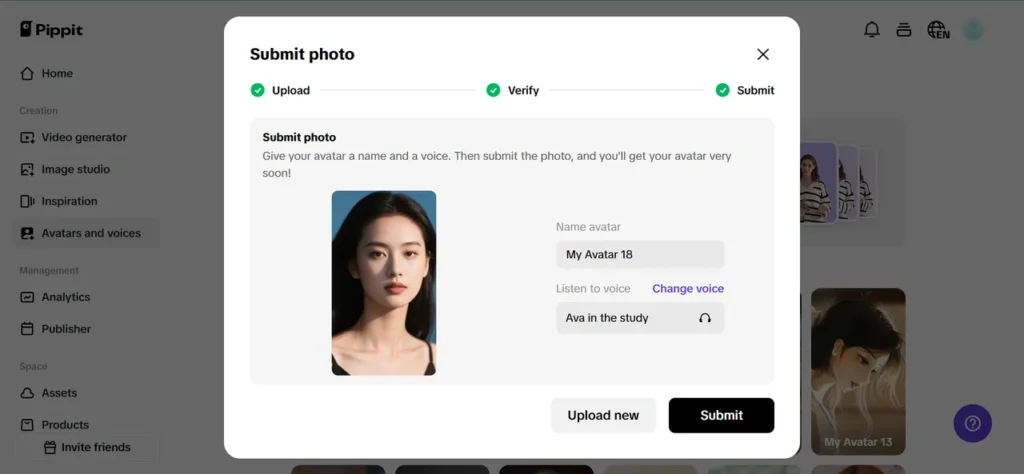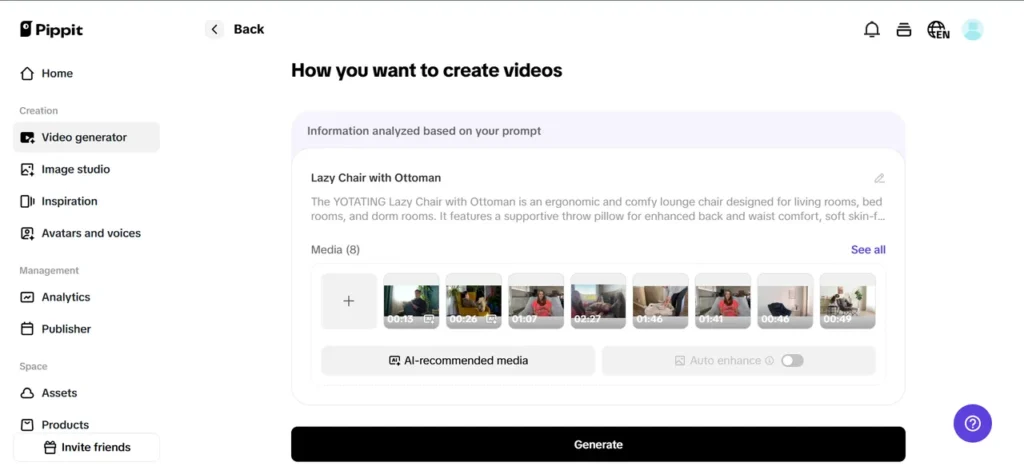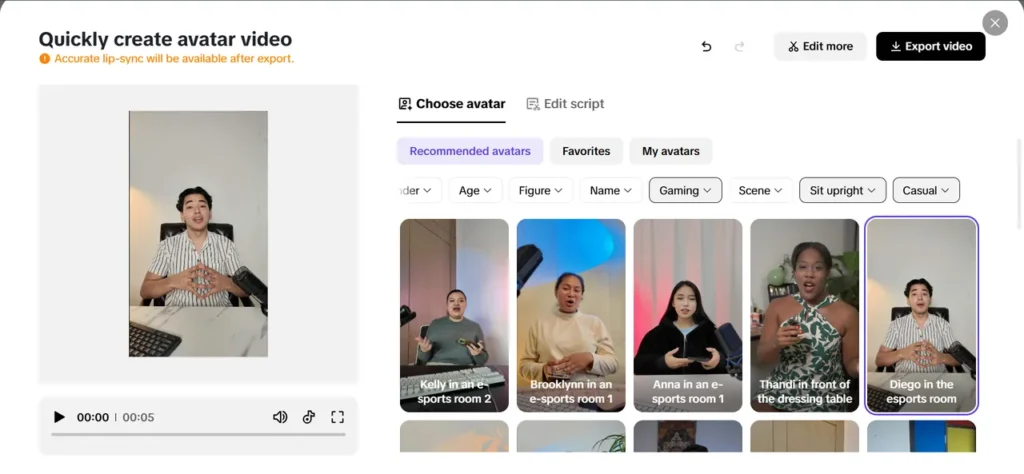
You’d better hurry up. Before the spectator scrolls away, you have thirty seconds to introduce your goods, win over the audience, and perhaps even give them a wink. Which is more adept at the job—a human spokesperson ready for the camera or an AI avatar with perfect pixels?
Welcome to the showdown.
Thanks to tools like Pippit’s link to video converter, brands are now turning static product photos into dynamic explainers using AI avatars that talk, gesture, and even match your tone.

Want to see one in action? Let’s dive into the advantages, quirks, and wildcard strengths of both sides of the screen!
The charisma meter: humans bring vibe, avatars bring variety
There’s no denying it — a human face with a real smile can draw people in. Human presenters carry subtle expressions, improv reactions, and cultural nuances that naturally land with the audience. But they also carry… tired eyes, bad lighting, wardrobe malfunctions, and creative burnout.
Meanwhile, a custom avatar is always fresh-faced and on-message. It never mispronounces your brand name or forgets the CTA. And with style presets and scene options in tools like Pippit, it’s never stuck in just one look. You can present the same product in 10 styles without booking 10 actors.

Humans
- Deep authenticity, especially for influencer-driven content
- Ideal for long-form demos or Q&A formats
- React well in unscripted moments
Avatars
- Perfect enunciation and pacing every time
- Easily switch outfits, expressions, and languages
- Doesn’t require reshoots when the lighting is off
So if your product demo involves a quick walkthrough from image slides, the avatar may be your MVP — especially when paired with photo to video AI that generates the scene behind them.
Attention span battle: who keeps it snappy?
Viewers make snap decisions in the first three seconds. If the speaker rambles, stutters, or opens with a generic hook, you’ve likely lost them. Human presenters, especially those new to the camera, often struggle to condense complex ideas.
Avatars, on the other hand, come pre-programmed for punchy pacing. You write the script, choose the tone, and the avatar delivers it without fluff. Want a 15-second voiceover that highlights key features? Easy. Want the same in French, Portuguese, or Urdu? Just toggle the voice setting.
This is where photo to video AI shines — turning a sequence of images into a sleek video that feels polished, quick, and viewer-friendly. Avatars don’t get flustered. They hit the mark on the first try.

Brand consistency: the unspoken winner
Consistency might not win applause, but it builds trust. Audiences who recognize your signature tone, look, and message style are more likely to convert. Humans, while relatable, can vary dramatically across shoots depending on mood, lighting, or energy levels.
A custom avatar remains rock-steady. Same smile. Same vibe. Whether it’s your Monday campaign or Friday flash sale, they look the same and stay on-brand. They also pair seamlessly with design elements like on-screen text, logo animations, or interactive buttons — no complex editing required.
And if you’re working across multiple markets, that avatar can be duplicated, localized, and deployed in minutes. No need for international casting calls or endless back-and-forth with regional talent.
The expressive edge: avatars are catching up fast
There was a time when avatars felt robotic. Blank stares. Stiff mouths. The uncanny valley in full effect. But not anymore. Today’s avatars, especially when built through platforms like Pippit, include nuanced expressions — from eyebrow raises to smirks — that align with your message.
The expressive library includes:
- Emotional presets for comedy, romance, urgency, or calm
- Natural blinking, head tilts, and hand gestures
- Face tracking that adapts to language tone and speech speed
While a human still outperforms when it comes to complex emotional storytelling, avatars now do a fantastic job in casual, high-volume content. Need to post five daily reels across platforms? That’s where they win.

Final round: when hybrid is the smartest choice
It’s not always either-or. Some of the smartest brands use both: a human voiceover layered on a sleek avatar, or a human host that hands off to an avatar for feature deep-dives. This hybrid approach gives you the best of both worlds — emotional authenticity and consistent delivery.
In fact, many teams now repurpose behind-the-scenes photos, user-submitted images, and product stills into videos using photo to video AI, then have a custom avatar narrate the visuals. It’s a fast, efficient way to keep your content flowing — without filming a single new clip.
So the real question might not be who’s better, but who’s better for this moment?
When the lights go out, avatars don’t need a good hair day
Let’s be honest — traditional video shoots can be chaotic. Lighting setup, background cleanup, retakes because someone sneezed in the middle of a perfect take. And that’s before you’ve even edited the footage. Human presenters, even the most experienced ones, are affected by energy, timing, and, yes, how their hair behaves that day.
Avatars, on the other hand, show up fully styled and ready 24/7. There’s no need to schedule a golden hour shoot or worry about noise from the street. Whether it’s Monday morning or midnight on a deadline, your custom avatar looks sharp, sounds crisp, and delivers your script with zero drama.

This is especially useful when you’re converting static assets — like product stills or catalog shots — into scroll-stopping explainers using photo-to-video AI. You don’t have to set up a physical scene or coach someone to ‘look more excited.’ The avatar nails the expression every time, giving you content that’s polished without production pain.
So next time your team’s scrambling for a last-minute campaign video and your lead presenter’s stuck in traffic, remember: the avatar’s already camera-ready.
Avatars are the clear winners of the 30-second format
Avatars offer unparalleled speed, style, and scalability in the realm of fast-scroll platforms such as YouTube Shorts, TikTok, and Reels. Although humans continue to play a part, particularly in long-form and private material, avatars provide an on-demand presence that never requires a coffee break.
Additionally, Pippit makes it easier than ever to establish that presence. Just upload your script, apply your visuals, choose your avatar, and click export.
Want to try it yourself? Start creating your avatar-powered explainers today with Pippit — no lights, camera, or makeup required!






Leave a Reply